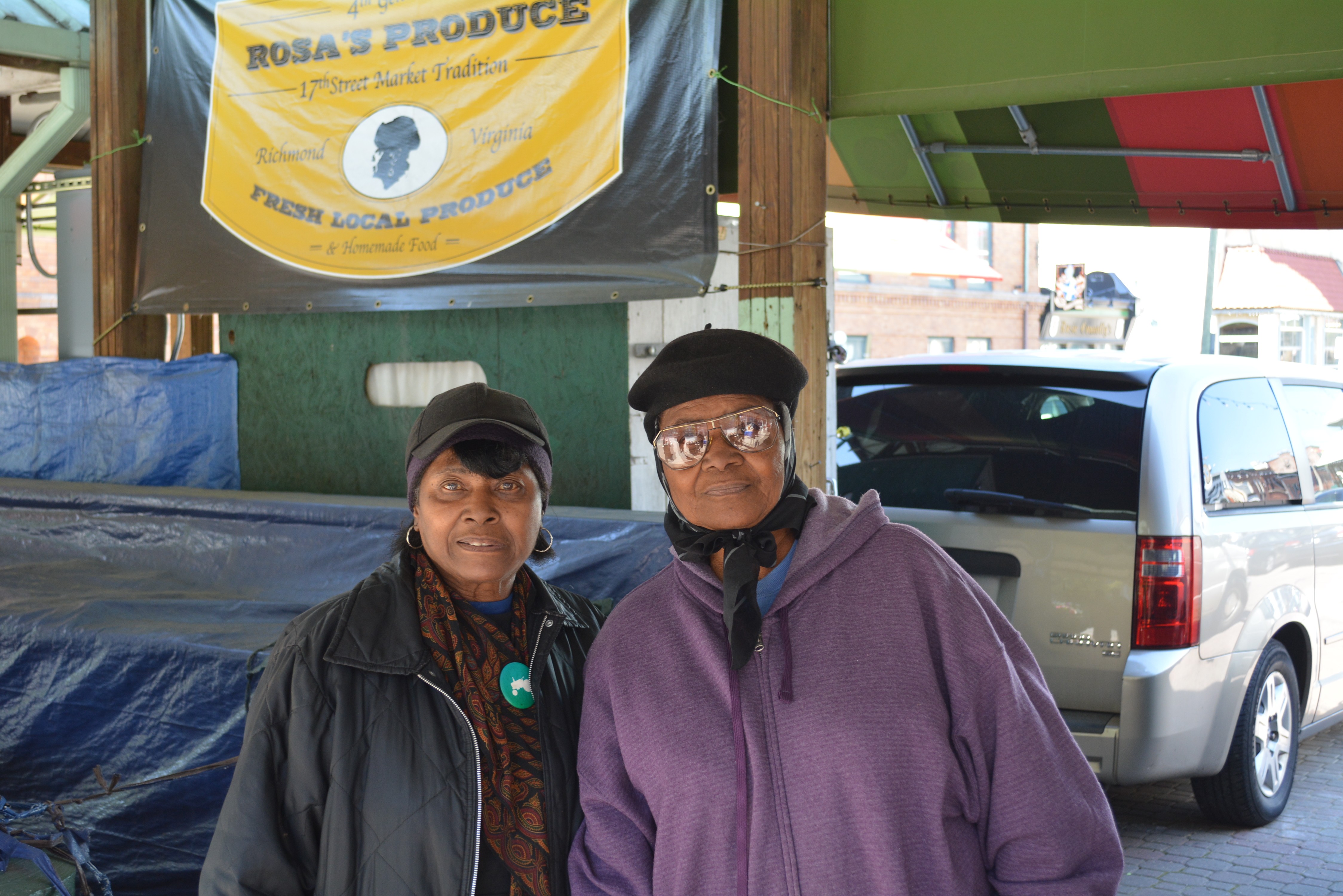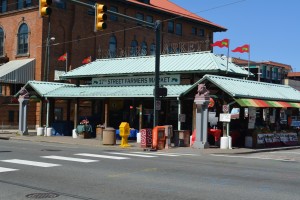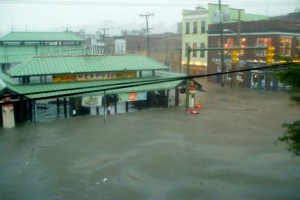
Sisters Rosa Fleming (left) and Evelyn Allen (right) have kept their family legacy alive at the 17th Street Market through Shockoe Bottom’s redevelopment. Photo by Garrett Fundakowski.
FROM THEIR FRUIT AND VEGETABLE STANDS at the 17th Street Market in Shockoe Bottom, sisters Rosa Fleming, 79, and Evelyn Allen, 81, have watched and lived through the roller coaster existence of Richmond’s “Bottom” for 75 years.
Their family has worked these stands as vendors for four generations—over half of the 279 years that the market has been in existence. Staring at an old picture of her kid brother selling produce, Evelyn laughed at the way things used to be. Back then, “the community was a family and the market was the middle of it,” she says.
“We’ve seen the market change, people come and go, but we’re always here,” adds Rosa.
From Reconstruction through the 1960’s, Shockoe Bottom was the historic and economic heart of Richmond. But as industries moved on and local merchants left, the neighborhood’s prosperity collapsed. Always a danger in this low-lying basin, the threat of flooding kept people from rebuilding.
In 1994 a massive $143 million floodwall (right) was built to bring a sense of stability to the floodplain neighborhood. “People felt safe,” reflects Rosa. “Old warehouses became apartments and restaurants came everywhere. People were coming back.”
Then came August 30, 2004.
A category Five storm, Hurricane Gaston, assaulted the city with 14 inches of rain in just over an hour. Flooding from rainwater rendered the floodwall useless. Water came rushing into the city’s lowest neighborhood from the overwhelmed storm drains. Within 30 seconds the water rose from four inches to four feet, peaking at 27 feet above sea level—the wall kept the water in the neighborhood. “It happened so fast,” remembers Rosa. “We got our butts out of there.”
Amid $20 million in damages to 50 local businesses, over a dozen never reopened. “That really set everything back,” notes Evelyn, shaking her head.
The city responded in 2009 with an economic revitalization strategy designed to revamp the storm drainage systems and also bring development to the Bottom.
This plan included redeveloping 17th Street Market into a plaza next to the soon-to-be-rebuilt Main Street Train Station to bring new vibrancy to the neighborhood. But the sisters had seen too much over the years to trust the city.
Richmond city council wanted to put a baseball stadium in the heart of the Bottom and invest in large businesses in order to drive pure economic growth. Opposition groups had long been fighting for a slavery memorial park and museum in the same area, which is the site of Lumpkin’s slave jail and burial ground. The stadium plan was abandoned, but the memorials never came and the city continues to push for similar developments.
Richmond’s past is marked by its Confederate and slave history, with over 25% of African Americans today able to trace their roots to the slave auction market in Richmond. It is a part of the city, much like the 17th Street Market.
Ana Edwards, Chair of the Sacred Ground Historical Reclamation Project, explains how important this history is, then voices her frustrations. “People are finding their interests come last as the city focuses only on money coming in. This [development] doesn’t help the community. People are priced out of their homes and our history is being wiped out.”
Rosa and Evelyn felt this too.
“Change, change, change. That’s all they talked about, but never how it would help us,” sighs Evelyn. The sisters did not budge, however. “If they didn’t work with us, we weren’t going no place.”
The sisters are tough and know how to make themselves heard. Coming from a family of 15 siblings and 67 foster siblings will teach you that. As we speak, Evelyn points out her favorite possession at the market—a wooden plank with a nail protruding from one end she keeps at her stand.
They also had leverage.
The sisters are protected legacies of the Market and could not be removed. The city agreed to grandfather them in to the new Shockoe Square that will be completed in April of 2017.
Rosa can’t help but smile as she thinks about what the empty lot behind her will become. “It’s going to be beautiful. There will be a public plaza, trees, outdoor seating at all the restaurants, and the train station will bring more people. Our community is coming back and our history will be front and center.”
The sisters understand how unique their situation is. “We had the power to make the city work with us. They don’t see communities in their plans, just money, and the rest of Shockoe Bottom is hurting from it,” acknowledges Rosa.
The city struggles to reconcile its past with its future and economic growth with real community development. The defiant sisters showed how development can incorporate both. “I thank God every day that I am able to carry on this legacy and continue to do what I’m doing,” says Rosa.
By Will Hogge




